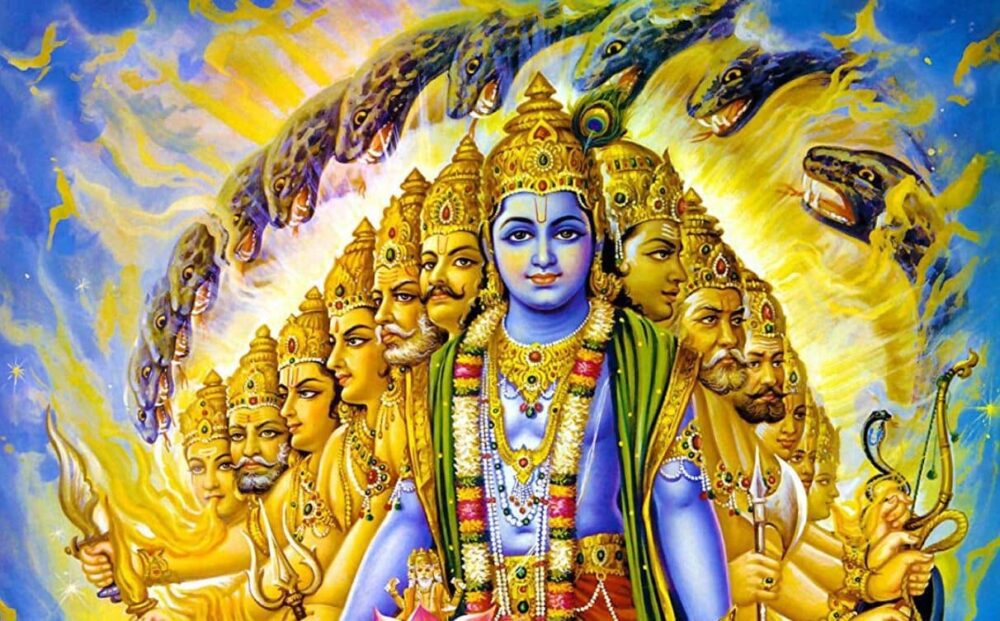Lord Krishna, one of Hinduism’s most well-known and revered deities, is a prominent deity. He is frequently shown as a philosopher, teacher, and celestial hero. Krishna is known for his cunning, humorous nature, brilliance, and devotion to his devotees.
Krishna is the main character in the Hindu sacred book known as the Bhagavad Gita and a significant figure in the Mahabharata. You might be interested in these 25 fascinating pieces of information and facts regarding Lord Krishna that we will discuss in this article so grab your pen and note it down.
Lord Krishna Facts:
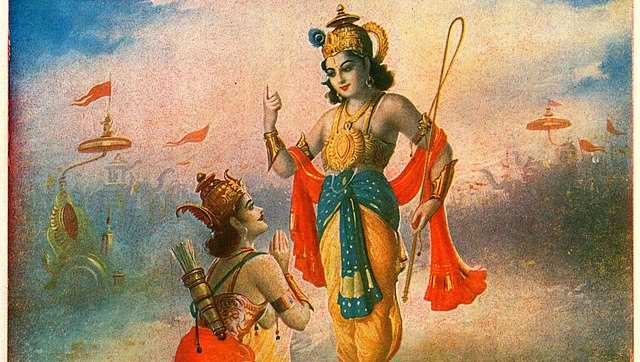
- Hindus come together to celebrate Lord Krishna’s birth as Janmashtami because he is regarded as Lord Vishnu’s eighth avatar. Hinduism holds that Lord Krishna was born to Devaki and Vasudeva in Mathura and raised in Vrindavan.
- One of Lord Krishna’s most distinctive and iconic characteristics is that he is frequently shown playing the flute. Hindu mythology states that everyone who heard Krishna’s flute had a mystical and hypnotic reaction to its sound. Those who heard the music were believed to experience intense love and longing, and he frequently utilized the music to beckon his followers to him.
- Due to his dark skin tone, Lord Krishna is commonly referred to by the terms “Dark Lord” or “Shyam.” His skin tone is compared to that of a dark raincloud or a brand-new monsoon cloud in Hindu mythology. In Sanskrit, the word “Krishna” itself signifies “dark” or “black,” and it is thought that the deity’s dark skin symbolizes both his divine nature and his connection to the universe.
- Frequently, Krishna is shown with a peacock feather on his head. Lord Vishnu, the universe’s protector, took on the form of Krishna. In addition to his wisdom and compassion, Krishna is renowned for his playful and mischievous personality. The wing of a peacock, which is thought to be a reflection of his heavenly traits, stands in for his beauty, grace, as well as royal nature.
- Radha was Krishna’s childhood companion and consort, and he is well renowned for his heavenly love and devotion to her. The love tale of Radha and Krishna is a well-liked subject in Hindu literature and art, and it is frequently regarded as the pinnacle of heavenly love and devotion. Hinduism holds that Krishna is the manifestation of Lord Vishnu, the universe’s protector, and Radha is the embodiment of the deity of love and devotion.
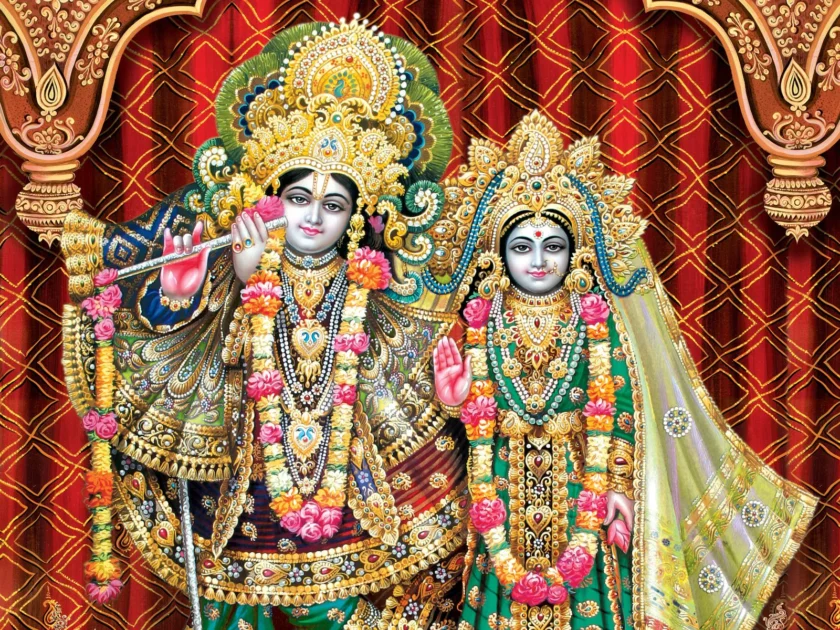
6. One of the most famous friendships in Hindu mythology is between Lord Krishna and Arjuna. The protagonist of the Mahabharata, Arjuna, was a warrior prince who served as Krishna’s counselor and charioteer during the decisive battle of Kurukshetra. The foundation of Krishna & Arjuna’s friendship was respect, trust, as well as admiration. Arjuna was a devout follower of Lord Krishna and a great fighter.
7. Hindu mythology holds Krishna in high respect as a brilliant negotiator and strategist, and his advice to the Pandavas during the Mahabharata battle is evidence of his strategic acumen. The Pandavas’ victory in the Mahabharata war against the Kauravas was made possible in large part by Krishna’s guidance and counsel. He was crucial in forging agreements with other kingdoms and convincing them to side with the Pandavas, which strengthened their army.
8. Krishna is frequently seen with cows since it is thought that he was a cowherd as a boy. Hindu mythology states that Krishna spent his early life at Vrindavan, a tiny village close to Mathura, where he enjoyed playing the flute and herding cows with his pals. In Hinduism, the cow is revered as a sacred animal and is frequently connected to riches, good fortune, and maternal affection. Since cows give humanity food and nutrition, they are also thought to symbolize the divine mother.
9. Many myths describe Lord Krishna’s youthful playfulness and mischievousness. He is commonly described as an amicable and sardonic boy who loved playing with his friends and family. One of the most well-known legends regarding Lord Krishna’s mischievous behavior is that he enjoyed stealing butter, or “Makhan Chor.” As a young child, Lord Krishna frequently sneaked into the homes of cowherds and stole butter from their jars since he liked butter so much. This funny robbery has gained popularity in Indian literature and art, and sculptures and paintings commonly depict it.
10. Krishna’s act of uplifting the Govardhan hill to shield his people from a storm brought by Indra, the king of the gods, is one of the most well-known tales of his bravery. According to tradition, Indra became enraged because the inhabitants of Vrindavan chose to worship Krishna rather than him and resolved to punish them by sending a terrible storm. But since Krishna was aware that the storm would be disastrous, he used his pinky finger to lift the whole Govardhan hill and shield the inhabitants and animals from the downpour.
Also Read:
- Norse Mythology: 15 Most Important Gods and Goddess
- Famous Temples That You Shouldn’t Miss Visiting If You Are Traveling To Tamil Nadu
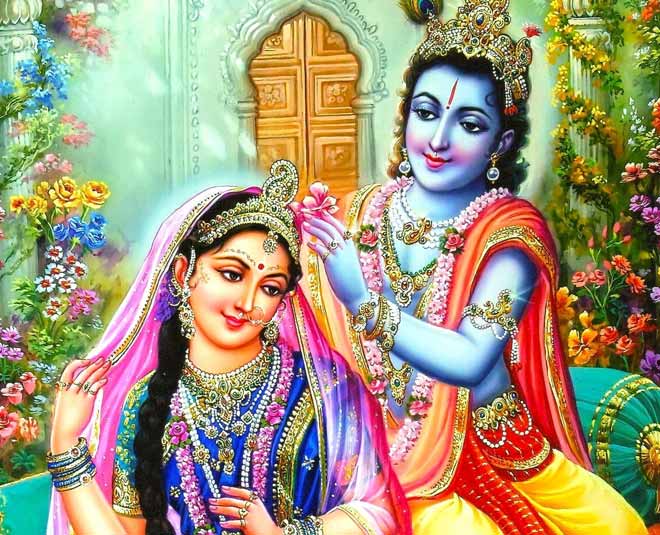
11. At Vrindavan, where Lord Krishna spent his early years, the legend has it that he and his pals used to celebrate Holi with colored water and paint. The jovial and naughty Holi festivities of Krishna and his pals have entered Indian tradition and are still cherished and joyfully observed today.
12. On the 8th day (Ashtami) of the dark fortnight of the Hindu month of Bhadrapada, Lord Krishna was born. His parents, Vasudeva and Devaki, gave birth to him at Mathura. But because it was predicted that his uncle Kansa would kill him, he was surreptitiously transported to Gokul and nurtured there by his foster parents, Nanda and Yashoda.
13. Hindu mythology holds that Krishna had 16,108 wives in total. But his love for Radha is regarded as the greatest and most sincere kind of love. Despite having several wives, Lord Krishna had a special and one-of-a-kind devotion to Radha. They were regarded as soulmates since their love went beyond physical attraction to include spiritual affection. Hindu legend states that even though Lord Krishna left his home of Vrindavan to carry out his responsibilities as a prince and eventually as a king, Radha’s devotion to him never changed.
14. The lotus flower, referred to as the “Padma” in Hinduism, is frequently connected to celestial entities and enlightenment. The lotus blossom is thought to stand for enlightenment and the arousal of spiritual consciousness. In Hindu mythology, Krishna is frequently shown either standing on a lotus flower or holding one. This represents his spiritual connection to the almighty and his unadulterated, enlightened essence.
15. The Hindu festival of Dahi Handi, which is mostly observed in the Indian state of Maharashtra but also elsewhere in India, is intimately tied with Krishna. The festival is observed the day following Janmashtami, the occasion of Lord Krishna’s birth.
In the hopes of breaking a jar of curd or butter that is suspended at a height, human pyramids are formed during the Dahi Handi event. Players are referred to as “Govindas,” and the pot is known as “handi.” The human pyramid portrays the attempt made by Krishna and his companions to take butter and curd from the jars that the cowherds had hidden from their reach.
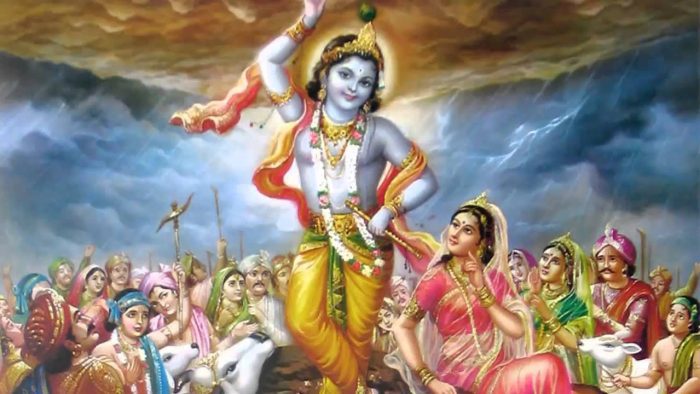
16. He is claimed to have a hundred names, or “Sahasranama,” according to Hindu mythology, every one of which is said to symbolize a particular facet of his character, divinity, and teachings. The Sahasranama, one of Hinduism’s most revered hymns, is a collection of a thousand various names for Lord Krishna. It is frequently repeated as a way to pray or worship and is thought to have the ability to call upon Lord Krishna’s blessings and protection.
17. In Hinduism, the name “Krishna” can be interpreted in a variety of ways. “Dark” or “black” is one of the name Krishna’s most popular derivations. This is so because Hindu mythology and art frequently depict Krishna as having dark or black skin. According to legend, Krishna’s dark complexion represents both his pure nature and his capacity to withstand and soak up all negativity.
18. Due to his unique relationship with his sister Subhadra, Krishna is tied with Raksha Bandhan. Subhadra was the younger sister of Krishna, who cherished her, according to Hindu mythology. Subhadra once tied a holy thread, or “rakhi,” on Lord Krishna’s wrist to ask for his protection from evil powers. Lord Krishna then vowed to constantly defend her. This occurrence is thought to be the origin of the custom of a sister tying a rakhi around her brother’s wrist as a sign of her affection and wishes for his safety and protection.
19. Hindu mythology frequently shows Krishna as a warrior, driving a chariot and brandishing a bow and arrow, particularly in the Mahabharata epic. He was the charioteer and counselor to the Pandava prince Arjuna during the Kurukshetra War, the main conflict in the Mahabharata.
20. Krishna is connected to the holy Hindu sound “Om” since it is said that he represents the essence of the cosmos and all of creation. The cosmic resonance that underlies all existence is represented by the sound “om,” which is regarded as the universe’s first sound. Krishna is frequently seen playing the flute, and it is believed that this is a symbol of the divine sound “Om” All living things are supposed to be drawn to and enchanted by the song of his flute, which makes it a representation of the ultimate harmony and unification of the universe.
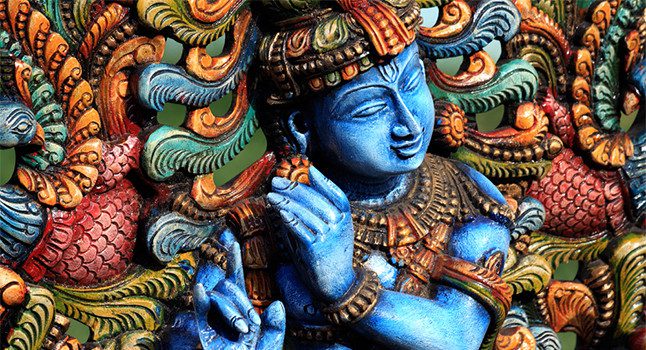
21. The Hindu festival of Annakut or Annakoot, which is observed in several regions of India the day following Diwali or Govardhan Puja, is linked to Krishna. The event involves giving a tower of food to Krishna and his followers. The name “annakut” implies a “mountain of food.” When Indra, the ruler of the gods, launched a violent storm, Krishna once raised Govardhan Hill to shield the inhabitants of Vrindavan from it. The citizens of Vrindavan presented Krishna and his followers with a mountain of food as a sign of thanks and celebration for their support during his victory. According to legend, this custom gave rise to the contemporary Annakut celebration.
22. During the Hindu holiday of Gopastami, Krishna’s activities as a young cowherd lad are commemorated. When Krishna was a little child, his father would bring his cows and calves to graze in the grasslands close to the Yamuna River. It is said that Krishna’s father Nanda Maharaja handed him his own cows to look after on the day of Gopastami, signifying that he had grown as a person and was now a capable cowherd.
23. Makar Sankranti is linked with Lord Krishna because it is said that on this day, the demon Sankhasura, who had transformed into a conch and was wreaking havoc throughout the earth, was slain. As Krishna slew the demon with his Sudarshana Chakra, the day became known as Sankranti, or “the end of the demon.”
24. Gita Jayanti is also connected to Krishna. A Hindu celebration called Gita Jayanti commemorates the occasion when Lord Krishna gave Arjuna the Bhagavad Gita, one of the most significant Hindu scriptures, on the field of battle at Kurukshetra. It takes place on the eleventh day of the waning moon in the Hindu month of Margashirsha, which often occurs in November or December.
25. One of the most well-known tales from Hindu mythology is the one about Krishna and Sudama. Krishna had a childhood buddy named Sudama who came from a low-income family. In order to get Krishna’s assistance in conquering his family’s financial hardship, Sudama made the decision to go to his castle one day. For several days, Sudama resided with Krishna and the two friends talked about their youth.
Sudama didn’t tell Krishna about his predicament since he was too ashamed to beg for assistance. Krishna, however, was aware of Sudama’s plight and want to assist him. Krishna gave Sudama a bag filled with gold and gems before he went.
Your Turn!
Lord Krishna is a highly revered and adored deity in Hinduism because of his complex character and divine nature. He is associated with many different occasions and traditions, each of which highlights a certain aspect of his character and behavior. The stories of Lord Krishna’s playful boyhood, his role as a wise diplomat and strategist, his devotion to his friend Sudama, and his love for Radha never fail to inspire and enchant devotees and followers of all ages. His lessons contained in the Bhagavad Gita continue to provide wisdom and guidance to millions of people around the globe.
Tell us which was your favourite point in the article in the comments section.

